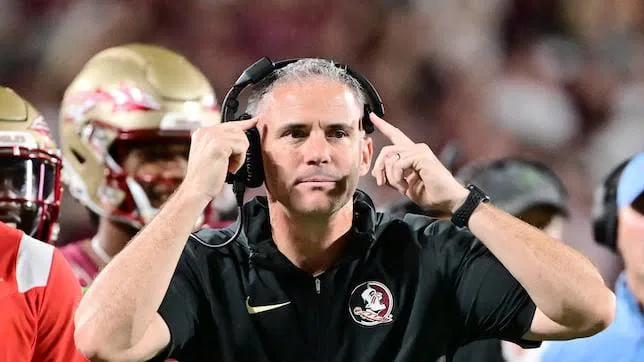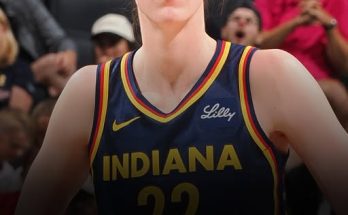The Florida State Seminoles football program has consistently been a powerhouse in college football, with a rich tradition of success, from their national championships to consistent bowl game appearances. However, every season comes with its challenges, and one of the most significant hurdles that any football team faces is injuries. Injuries can significantly affect a team’s performance and potentially alter the trajectory of the season. As the Seminoles look to continue their rise in the ranks of college football, one particular injury has garnered much attention: that of wide receiver Duce Robinson.
Injuries to key players can drastically impact a team’s offensive and defensive schemes. Wide receivers, in particular, are often seen as game-changers, and the loss of a promising talent like Duce Robinson has the potential to shift Florida State’s offensive strategy. As of the latest reports, head coach Mike Norvell has spoken out about Robinson’s recovery and provided updates on his progress. This article will delve into Robinson’s injury, his recovery timeline, and what it could mean for the Florida State Seminoles moving forward.
Who is Duce Robinson?
Before diving into the specifics of his injury and recovery, it’s important to understand who Duce Robinson is and why his injury is such a significant topic for Florida State fans.
Duce Robinson is a highly touted wide receiver who arrived at Florida State with a lot of excitement surrounding his potential. A five-star recruit out of Georgia, Robinson was widely regarded as one of the best wide receiver prospects in the nation. His ability to stretch the field, make explosive plays, and create mismatches in the secondary made him an instant standout. Standing at 6’4” and weighing around 210 pounds, Robinson possesses the rare combination of size, speed, and hands that makes him a dangerous weapon on the field. His ability to high-point the ball and make contested catches is something that immediately stood out during his high school career.
As a freshman, Robinson was expected to have an immediate impact for Florida State’s offense. His physical attributes, combined with his skill set, made him a key piece in the Seminoles’ plans for the upcoming season. Quarterback Jordan Travis and the rest of the offense were looking forward to utilizing Robinson’s big-play ability to open up the field and give them more options in the passing game.
However, as with many promising players, the road to success was not without its obstacles, and Robinson’s injury became a focal point for the team as they prepared for the season.
The Injury: A Setback for Robinson and the Seminoles
The injury that has put Robinson’s season on hold is a knee injury, which occurred during the offseason leading up to the 2025 season. The details of the injury itself are not entirely clear, but reports suggest that Robinson sustained damage to his ACL, the ligament that is crucial for stabilizing the knee joint during athletic movements like cutting, jumping, and sprinting. ACL injuries are particularly common in football, especially for players who rely on explosive speed and agility, such as wide receivers.
For Robinson, the timing of the injury was unfortunate. It happened during a crucial time when he was working hard to develop chemistry with the team and especially with starting quarterback Jordan Travis. The injury not only threatened to sideline Robinson for a portion of the season but also put a significant dent in the Seminoles’ offensive plans.
While any injury is disappointing, the impact of Robinson’s injury was felt more acutely because of the expectations surrounding him. With the departure of some key players from the previous season’s roster, Robinson was expected to fill a larger role in the passing game. His injury meant that Florida State had to make some adjustments and figure out how to navigate the season without one of their most talented playmakers.
Mike Norvell’s Updates on Duce Robinson’s Recovery
As head coach of the Florida State Seminoles, Mike Norvell has made it a point to provide updates on Robinson’s recovery and the team’s plans going forward. Norvell has been very open with the media and fans about Robinson’s progress, providing a sense of optimism but also acknowledging the challenges that come with recovering from an ACL injury.
In his most recent press conferences, Norvell spoke about Robinson’s determination and mental toughness throughout the recovery process. “Duce has been working incredibly hard,” Norvell stated. “He’s a competitor, and he’s doing everything in his power to get back on the field. We’re doing everything we can as a program to support him during this process.”
Norvell emphasized that Robinson’s recovery was a gradual process. Given the severity of an ACL injury, rehabilitation and recovery are not quick fixes, and the timeline for full recovery can vary. Typically, players who suffer ACL injuries require anywhere from six to nine months of recovery before they can fully return to the field. For Robinson, this meant that he could potentially be sidelined for much of the 2025 season, though his recovery timeline was still up in the air.
Norvell, however, made it clear that the Seminoles’ medical staff and rehabilitation team were doing everything they could to speed up Robinson’s recovery while ensuring that he didn’t rush back too soon and risk further injury. He also highlighted that Robinson was showing great mental fortitude in his recovery efforts. “It’s not just about physical recovery; it’s about getting your mind right, and Duce has shown that he has the mindset to get back to where he was,” Norvell said. “We have full confidence in his dedication.”
The Impact on Florida State’s Offense
Robinson’s injury undoubtedly left a hole in Florida State’s offensive plans, particularly in the wide receiver position. As a young player with such a high ceiling, Robinson was expected to contribute immediately, and his injury forced the Seminoles to recalibrate their offensive scheme.
Without Robinson, FSU’s passing attack needed to rely more heavily on other receivers, including Johnny Wilson, Micah Pittman, and Ontario Wilson. These players had been contributors in the past, but none of them had the same physical attributes or potential to make the explosive plays that Robinson could bring to the table.
However, it’s important to note that Florida State has plenty of depth at the wide receiver position, and other players have stepped up to fill the void left by Robinson’s injury. The coaching staff has worked to implement a more balanced offense that takes advantage of the available weapons while still relying on the leadership of quarterback Jordan Travis.
In terms of play-calling, Norvell and his offensive staff have likely focused more on creating mismatches with existing players. For instance, Johnny Wilson’s size and ability to stretch the field will be more integral to FSU’s passing attack. Additionally, Micah Pittman, who is known for his quickness and route-running ability, will have to take on a larger role in the offense.
Despite these adjustments, it’s clear that Duce Robinson would have been a key player for FSU’s success in the 2025 season. His injury put a damper on the Seminoles’ hopes of having a high-powered, dynamic offense, and it meant that the team would need to rely on depth and versatility to fill the gap left by one of their most exciting young players.
What Does the Future Hold for Duce Robinson?
While the 2025 season may have been marred by Robinson’s injury, the future remains bright for the talented wide receiver. Robinson’s work ethic and recovery efforts suggest that he will eventually return to the field at full strength. If he stays on track with his recovery, he could be back by late in the season or potentially by the beginning of the 2026 season. His physical tools—speed, hands, and ability to make plays down the field—are still there, and with the right rehab, he could pick up right where he left off.
For Florida State, Robinson’s eventual return to the field will add another dynamic playmaker to their already potent offense. When fully recovered, Robinson could once again become one of the most dangerous wide receivers in college football, complementing the team’s passing attack and giving quarterback Jordan Travis an additional weapon to work with.
A Key Part of FSU’s Future
Injuries are an inevitable part of football, and Duce Robinson’s knee injury has undoubtedly been a setback for Florida State. However, with the leadership of Mike Norvell, the support of the medical staff, and Robinson’s own determination, the Seminoles remain optimistic about his recovery. Robinson’s eventual return will provide Florida State with another weapon on offense and potentially be the spark they need to compete at the highest level in college football.
While his absence has forced the Seminoles to adjust their offensive scheme, the team’s depth and versatility will allow them to navigate this difficult situation. As the season progresses, all eyes will be on Robinson’s recovery, and Florida State fans will be hopeful that their prized wide receiver will be back on the field sooner rather than later.
The road to recovery is never easy, but if Duce Robinson can continue to make strides in his rehabilitation, he could be a key contributor for Florida State’s football program for years to come. For now, the Seminoles will continue to adjust without him, but they remain hopeful that Robinson’s future with the team will be a bright one.



